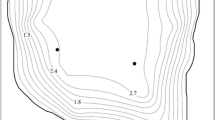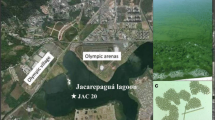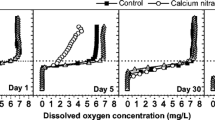Abstract
Management strategies that prevent the onset of nuisance and noxious cyanobacteria blooms are needed to preserve the integrity and safety of freshwater resource uses. Scientifically defensible data are needed regarding efficacy of proactive approaches in order to assist water resource managers in making informed decisions. As phosphorus availability has been indicated as a crucial aspect of cyanobacteria presence/dominance in freshwater systems, the integration of novel technologies to inactivate phosphorus is a critical component to achieve improved water quality. Phoslock (Phoslock Water Solutions, Ltd.) phosphorus locking technology is composed of the element lanthanum in a bentonite clay matrix that has a high specificity to bind and inactivate soluble reactive phosphorus. This research evaluated the phosphorus binding efficiency of Phoslock in aqueous and sediment matrices and the consequent impact on algae assemblage composition and water quality parameters. Laguna Niguel Lake in California afforded an opportunity to evaluate the operational effectiveness of Phoslock in a system historically plagued by high phosphorus concentrations, potentially toxic cyanobacteria (Aphanizomenonflos-aquae dominant), and lake closures. Phoslock was able to rapidly (<2 weeks) and significantly (p < 0.0005) decrease total (>80 %) and free reactive (>95 %) phosphorus in the water column and shift potentially releasable sediment phosphorus fractions to residual forms after treatment. Despite documented cyanobacteria blooms and high pretreatment cell densities, cyanobacteria levels remained below or near detection limits and only comprised a small fraction of the algae assemblage following Phoslock application. This study provides water resource managers an information on operational implementation and efficacy of a phosphorus binding technology.





Similar content being viewed by others
References
Boström, B., Andersen, J. M., Fleischer, S., & Jansson, M. (1988). Exchange of phosphorus across the sediment water interface. Hydrobiologia, 170, 229–244.
Briand, J. F., Jacquet, S., Bernard, C., & Humbert, J. F. (2003). Health hazards for terrestrial vertebrates from toxic cyanobacteria in surface water ecosystems. Veterinary Research, 34, 361–377.
Carpenter, S. R. (2008). Phosphorus control is critical to mitigating eutrophication. Proceedings of the National Academy of Sciences of the United States of America, 105, 11039–11040.
Chang, S. C., & Jackson, M. L. (1957). Fractionation of soil phosphorus. Soil Science, 84, 133–144.
Chorus, I., & Bartram, J. (1999). Toxic cyanobacteria in water: a guide to public health significance, monitoring and management. London: WHO. Chapman & Hall. 416 pp.
Clearwater, S. J. (2004). Chronic exposure of midge larvae to Phoslock. NIWA (National Institute of Water & AtmosphericResearch). Prepared for Ecowise Environmental Pty Ltd. NIWA Client Report No. AUS2004-005, August 2004.
Clearwater, S. J.& Hickey,C. W. (2004). Ecotoxicity testing of Phoslock on sediment-dwelling aquatic biota and rainbow trout.NIWA (National Institute of Water & Atmospheric Research). Prepared for Ecowise Environmental Pty Ltd. NIWA Client ReportNo. AUS2004-004, June 2004.
Diatloff, E., Asher, C. J., & Smith, F. W. (1993). Use of geochem-pc to predict rare-earth element (REE) species in nutrient solutions. Plant and Soil, 156, 251–254.
Dignum, M., Hoogveld, H. L., Floris, V., Gons, H. J., Matthijs, H. C. P., & Pel, R. (2004). Flow cytometric detection of phosphatase activity combined with 13C-CO2 tracer-based growth rate assessment in phytoplankton populations from a shallow lake. Aquatic Microbial Ecology, 37, 159–169.
Douglas, G. B. (2002). US Patent 6350383: remediation materialand remediation process for sediments. Alexandria, VA: U.S. Patent and Trademark Office.
Firsching, F. H., & Brune, S. N. (1991). Solubility products of the trivalent rare-earth phosphates. Journal of Chemical and Engineering Data, 36, 93–95.
Ganf, G. G., & Oliver, R. L. (1982). Vertical separation of the light and available nutrients as a factor of causing replacement of Green algae by Blue-green algae in the plankton of a stratified lake. Journal of Ecology, 70, 829–844.
Ghadouani, A., Pinel-Alloul, B., & Prepas, E. E. (2003). Effects of experimentally induced cyanobacterial blooms on crustacean zooplankton communities. Freshwater Biology, 48, 363–381.
Gibbs, M., Hickey, C. W., & O¨ zkundakci, D. (2011). Sustainability assessment and comparison of efficacy of four P-inactivation agents for managing internal phosphorus loads in lakes: sediment incubations. Hydrobiologia, 658, 253–275.
Gonsiorczyk, T., Casper, P., & Koschel, R. (1998). Phosphorus binding forms in the sediment of an oligotrophic and a eutrophic hardwater lake of the Baltic lake district (Germany). Water Science and Technology, 37, 51–58.
Haghseresht, F., Wang, S., & Do, D. D. (2009). A novel lanthanum-modified bentonite, Phoslock, for phosphate removal from wastewaters. Applied Clay Science, 46, 369–375.
Hallegraeff, G. M. (1993). A review of harmful algal blooms and their apparent global increase. Phycologia, 32, 79–99.
Hupfer, M., Gächter, R., & Giovanoli, R. (1995). Transformation of phosphorus species in settling seston and during early sediment diagenesis. Aquatic Sciences, 57, 305–324.
Jansson, M., Olsson, H., & Petterson, K. (1988). Phosphatases; origin, characteristics and function in lakes. Hydrobiologia, 170, 157–175.
Jeppesen, E. M., Søndergaard, J. P., Jensen, K. E., Havens, O., Anneville, L., Carvalho, M. F., et al. (2005). Lake responses to reduced nutrient loading: an analysis of contemporary long-term data from 35 case studies. Freshwater Biology, 50, 1747–1771.
Kapanen, G. (2008). Phosphorus fractionation in lake sediments. Estonian Journal of Ecology, 57, 244–255.
Kromkamp, J., Van Den Heuvel, A., & Mur, L. R. (1989). Phosphorus uptake and photosynthesis by phosphate-limited cultured of the cyanobacterium Microcystis aeruginosa. British Phycological Journal, 24, 347–355.
Lukkari, K., Hartikainen, H., & Leivuori, M. (2007). Fractionation of sediment phosphorus revisited. I: fractionation steps and their biogeochemical basis. Limnology and Oceanography-Methods, 5, 433–444.
Lurling, M., & Tolman, Y. (2010). Effects of lanthanum and lanthanum-modified clay on growth, survival and reproduction of Daphnia magna. Water Research, 44, 309–319.
Mehner, T., Diekmann, M., Gonsiorczyk, T., Kasprzak, P., Koschel, R., Krienitz, L., et al. (2008). Rapid recovery from eutrophication of a stratified lake by disruption of internal nutrient load. Ecosystems, 11, 1142–1156.
Meis, S., Spears, B. M., Maberly, S. C., O’Malley, M. B., & Perkins, R. G. (2012). Sediment amendment with Phoslock in Clatto Reservoir (Dundee, UK): investigating changes in sediment elemental composition and phosphorus fractionation. Journal of Environmental Management, 93, 185–193.
Microsoft. (2010). Microsoft Excel [computer software]. Redmond, Washington.
Nürnberg, G. (1997). Coping with water quality problems due to hypolimnetic anoxia in Central Ontario Lakes. Water Quality Research Journal of Canada, 32, 391–405.
Ode, P. R. (2007). Standard operating procedures for collecting macroinvertebrate samples and associatedphysical and chemical data for ambient bioassessments in California. California State Water Resources Control Board Surface Water Ambient Monitoring Program (SWAMP) Bioassessment SOP 001.
Paerl, H. W. (1990). Physiological ecology and regulation of N2 fixation in natural waters. Advances in Microbial Ecology, 11, 305–344.
Paerl, H. W., Prufert, L. E., & Ambrose, W. W. (1991). Contemporaneous N2 fixation and oxygenic photosynthesis in the nonheterocystous mat-forming cyanobacterium Lyngbya aestuarii. Applied and Environmental Microbiology, 57, 3086–3092.
Pettersson, K., & Istvanovics, V. (1988). Sediment phosphorus in Lake Balaton: forms and mobility. Archives Hydrobiology, 30, 25–41.
Psenner, R., Boström, B., Dinka, M., Petterson, K., Pucsko, R., & Sager, M. (1988). Fractionation of phosphorus in suspended matter and sediment. Archives Hydrobiology, 30, 98–103.
Reitzel, K., Andersen, F. O., Egemose, S., & Jensen, H. S. (2013). Phosphate adsorption by lanthanum modified bentonite clay in fresh and brackish water. Water Research, 47(8), 2787–2796.
Richards, A. B., &Rogers, D. C. (2006). List of freshwater macroinvertebrate taxafrom California and adjacent states including standard taxonomic effort levels.Southwest Association of Freshwater Invertebrate Taxonomists (SAFIT). 215 pp.
Robb, M. S., Greenop, B., Goss, Z., Douglas, G., & Adeney, J. (2003). Application of Phoslock, an innovative phosphorus binding clay, to two Western Australian waterways: preliminary findings. Hydrobiologia, 494, 237–243.
Ross, G., Haghseresht, F., & Cloete, T. E. (2008). The effect of pH and anoxia on the performance of Phoslock, a phosphorus binding clay. Harmful Algae, 7(4), 545–550.
Rydin, E., & Welch, E. B. (1999). Dosing alum to Wisconsin lake sediments based on in vitro formation of aluminum bound phosphate. Lake and Reservoir Management, 15, 324–331.
Schindler, D. W. (2012). The dilemma of controlling cultural eutrophication of lakes. Proceedings of the Royal Society of Biological Sciences, 279, 4322–4333.
Schindler, D. W., Hecky, R. E., Findlay, D. L., Stainton, M. P., Parker, B. R., Paterson, M., et al. (2008). Eutrophication of lakes cannot be controlled by reducing nitrogen input: results of a 37 year whole ecosystem experiment. Proceedings of the National Academy of Sciences of the United States of America, 105, 11254–11258.
Seale, D. B., Boraas, M. E., & Warren, G. J. (1987). Effects of sodium and phosphate on growth of cyanobacteria. Water Research, 21, 625–631.
SigmaPlot version 12.1. 2013. Systat Software, Inc., San Jose, California.
Smith, V. H. (1983). Low nitrogen to phosphorus ratios favor dominance by blue-green algae in lake phytoplankton. Science, 221, 669–671.
Søndergaard, M., Jensen, J. P., & Jeppesen, E. (2003). Role of sediment and internal loading of phosphorus in shallow lakes. Hydrobiologia, 506–509, 135–145.
Spears, B. M., Carvalho, L., & Paterson, D. M. (2007). Phosphorus partitioning in a shallow lake: implications for water quality management. Water and Environment Journal, 21, 43–53.
Spears, B. M., Carvalho, L., Perkins, R., Kirika, A., & Paterson, D. M. (2012). Long-term variation and regulation of internal phosphorus loading in Loch Leven. Hydrobiologia, 681, 23–33.
Standard methods for the examination of water and wastewater, 21st ed. (SMEWW). (2005). American Public Health Association. DC: Washington.
United States Environmental Protection Agency (USEPA). (1978). Method 365.3 Phosphorous, All Forms (Colorimetric, Ascorbic Acid, Two Reagent).
United States Environmental Protection Agency (USEPA) (2011). National Pollutant Discharge Elimination System (NPDES). Pesticide General Permit (PGP) for Discharges from the Application of Pesticides. Washington, DC.
Watson-Leung, T. (2009). Phoslock toxicity testing with three sediment dwelling organisms (Hyalella azteca, Hexagenia spp. andChrinonomus dilutes) and two water dwelling organisms (Rainbow Trout and Daphnia magna). Aquatic Toxicology Unit,Ontario Ministry of the Environment, Ontario, Canada.
Welch, E. B., & Cooke, G. D. (2005). Internal phosphorus loading in shallow lakes: importance and control. Lake Reservoir Management, 21, 209–217.
Acknowledgments
The authors thank AquaTechnex LLC personnel for their diligence in sampling, efficiency in application of Phoslock, and overall leadership of this project. Additional thanks to Orange County Parks and Recreation for their cooperation in implementation of this project and Phoslock Water Solutions, Ltd. for their technical support of this project.
Author information
Authors and Affiliations
Corresponding author
Rights and permissions
About this article
Cite this article
Bishop, W.M., McNabb, T., Cormican, I. et al. Operational Evaluation of Phoslock Phosphorus Locking Technology in Laguna Niguel Lake, California. Water Air Soil Pollut 225, 2018 (2014). https://doi.org/10.1007/s11270-014-2018-6
Received:
Accepted:
Published:
DOI: https://doi.org/10.1007/s11270-014-2018-6




